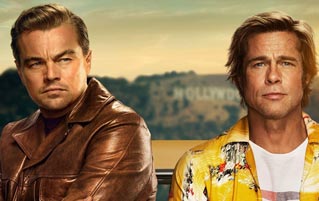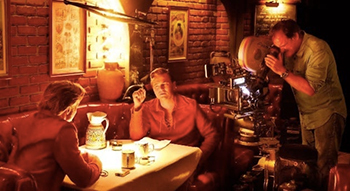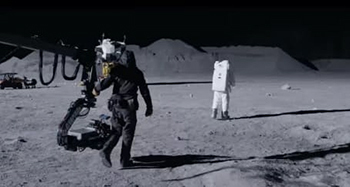6 Recent Movies With Bonkers Behind-The-Scenes Stories

A lot of hard work goes into filmmaking, from the lighting to the production design to the thousands of miserable hours spent making Sonic the Hedgehog look slightly less like an affront to God's creation. While every motion picture is probably a taxing experience (doubly so if it involves interacting with Russell Crowe), some filmmakers go above and beyond. So we'd like to take a moment and celebrate the hard work that went into some recent films. For example ...
Doctor SleepRebuilt The Overlook Hotel Using Kubrick's Blueprints
Stanley Kubrick's The Shining has inspired numerous parodies, insane theories, and even a full-fledged opera (hopefully featuring an oratorio dedicated to the blowjob furry). Now it has an official sequel, Doctor Sleep, which tells the story of how Danny Torrance has grown up to be one of those filthy dirtbag drifters with perfect teeth and movie star good looks.
Don't Miss
During the big finale, Dan returns to the Overlook because ... well, where did you think they were going to end it, a Best Western? While the original book doesn't feature the Overlook, since it burned down in the book of The Shining, here they could bring back the creepiest hotel in movie history (with the possible exception of that godforsaken Hotel for Dogs). And instead of digitally recreating the iconic set (as Ready Player One did), director Mike Flanagan decided they'd "just build everything," and they used Kubrick's original blueprints to do so. This included everything from the famous carpeted hallways ...

... to the lounge:


Any details Warner Bros. didn't have were "provided by the Kubrick estate." And as for details not included the blueprints, Flanagan analyzed the original movie in order to "track down every book on every shelf and every framed photograph on every wall." The crew would literally walk around the set with an iPad comparing it to the 1980 film. The reproduction was so faithful that it's surprising they didn't bring Shelly Duvall in just to scream at her and fill the space with her psychic trauma.
Following Kubrick's blueprints was also maddening at times. For instance, no one could figure out where the lobby doors were supposed to be in relation to the rest of the hotel. This was presumably a clue to who really killed Kennedy or something.
Related: 6 TV Shows That Put Insane Work Into Details Nobody Noticed
They Built A Full-Scale Lighthouse For The Lighthouse
Those craving an arthouse psychosexual thriller in which the Green Goblin and Edward from Twilight play volatile old-timey seamen were thrilled by The Lighthouse. The entire movie is set on a small island housing the titular phallic symbol. For his previous movie, The Witch, director Robert Eggers built a farm in the middle of nowhere. So of course this time he decided to build an entire lighthouse from scratch.
Despite the fact that there are already plenty of lighthouses that exist (at least, like, a dozen), Eggers couldn't find one he liked. So the production designer enlisted "everyone who could lift a hammer in Nova Scotia" for the "herculean task" of erecting a new lighthouse in Halifax, all for this one weird-ass movie.


Though it was made with plywood and covered in a sheet that resembled brick, the 70-foot structure had a working lantern made just for the movie, as well as an interior spiral staircase. It was "anchored by iron bars drilled into the bedrock" and "secured with several safety cables to withstand the wind" and presumably Willem Dafoe's scenery chewing as well.

The locals liked the new lighthouse so much that they wanted it to stay, but it was torn down after the production ended.
Related: 23 Movies That Put Insane Detail Into Stuff You Missed
Once Upon A Time In HollywoodRecreated A Drive-In Using Miniatures
Once Upon A Time In Hollywood is basically a classier Stranger Things for boomers. Instead of arcades and shopping malls, Quentin Tarantino went to absolutely nutty lengths to slavishly recreate 1960s Los Angeles. Like renovating the Musso and Frank Grill to make it look like it did in '69. He even asked the restaurateurs to dig their old dinnerware out of storage so that even the goddamn plates would be authentic.

The production recreated a ton of stores and movie theaters, including four straight blocks of Hollywood Blvd. Impressively, they even repainted the psychedelic facade of the Aquarius theater on Sunset.

And the shot in which Brad Pitt crosses through a Van Nuys drive-in to get to the trailer he lives in? Well, that drive-in isn't there anymore. So visual effects legend John Dykstra recreated it using miniatures. And since Tarantino hates CGI almost as much as he hates appendages that aren't feet, the cars are "physical toy cars."
Even the airplanes are miniatures. All of which makes us wonder if all the scenes with Al Pacino were shot Robot Chicken-style with a Scarface action figure.
Related: 17 Tiny Movie Details You Won't Believe Took Insane Work
ItWasn't Easy Bringing Walter White Back For El Camino
Essentially a feature-length epilogue for Breaking Bad, the Netflix movie El Camino reveals what happened to Jesse Pinkman immediately after the events of the series finale, which entails evading the police, searching for the money to start a new life, and somehow looking like a 40-year-old man even while everything else talks about him as "a kid."
It would be weird to have a Breaking Bad movie without Walter White, but barring some kind of twist involving black magic, we were all pretty sure Walt was going to stay dead. Instead, the movie includes a flashback in which Walt and Jesse grab breakfast.

While this might not seem like the most technically challenging scene, it totally was. Bryan Cranston was in the middle of performing in Network on Broadway. They had to fly him out on a private plane between performances, and had only 36 hours to shoot his cameo. Complicating matters, he couldn't just shave his hair and grow a mustache. So the crew had to do an elaborate makeup job, giving Cranston a bald cap and fake facial hair.
Wait, we're still not done. Walt's head looked "off" because of all the hair underneath that bald cap, which meant they had to digitally alter the size of Cranston's cranium. So instead of just scrambling some eggs, brewing some coffee, and letting the cameras roll, "every shot in that diner has a visual effects element in it."
Related: 6 Tiny Movie Moments That Took Insane Amounts Of Work
MidsommarMade A Self-Imploding Skull
In Midsommar, a group of Americans who act like hanging out in a creepy Swedish commune is basically Disneyland for grad students witness a horrifying ritual which most of them shrug off because, well, Sweden? Performing the (likely mythical) rite of Attestupa, two elders jump off a cliff, killing themselves so they won't be a burden to the community -- presumably since they'll no longer be asking the youths to show them how to use their phones all the damn time. But one of the elders survives the fall, so another villager helpfully puts an end to his suffering by caving his head in with a giant mallet, like some kind of morbid game of Pagan Nordic Whack-a-Mole.
To film the scene, the crew had a problem. They couldn't just fill a dummy head with blood and smash it, since that would only be good for one take. "Making enough for every conceivable reset was unworkable." Instead they built a head that could implode, then "un-smash itself" using "pneumatic cylinders," with the mechanics hidden in a hole underneath. Meaning that they could make the head smoosh with one button, then restore the "original, pristine face" with another.

They also had trouble getting the sound right, so foley artist Jay Peck had to use a real head ... in a manner of speaking. To capture the audio of smashing a human head, he went full Lord Of The Flies and procured a severed pig's head, then hit it with a wooden stump.

Not wanting to let a good pig's head go to waste, Peck used it again for some decapitation sound FX in the indie zombie flick The Dead Don't Die. He recorded himself "rolling" the "very gross" head on the floor and "tossing" it to his wife. Ah, the magic of the movies!
Related: 18 Throwaway Movie And TV Moments That Took A Ton Of Work
First ManWent To Insane Lengths For Space Realism
First Man might be one of the most realistic movies about space exploration ever. If nothing else, it shows space travel for the diarrhea-inducing nightmare it truly is. Director Damien Chazelle (who previously managed to turn a movie about drumming into a horror story) made the story of Apollo 11 super intense and visceral.
When it came to film the scenes on the moon itself, rather than simply have Ryan Gosling hop on a trampoline in front of a green screen, the crew actually created their own outdoor lunar surface at a quarry. Which became a problem when it snowed on the very first day of shooting.


Replicating the look of the sun on the moon was tricky, because they literally don't make lights bright enough to achieve the necessary effect. The filmmakers had to commission the creation of a new type of light bulb, twice as bright as the previous brightest one made for film shoots. The first time they tried to use it, it fucking blew up after only an hour. They had to use their backup bulb, keeping it cool with giant fans. They raised it 500 feet above the set and it still gave the crew actual sunburns.


They also wanted accuracy in their launch scenes, and thankfully, NASA had a ton of archival footage. First Man replicated this, and in some cases even used the original footage with modern enhancements. Which was a pain in the ass, because they had to use an "experimental scanner" to transfer the footage, which was shot on "NASA military-grade stock." Meaning that some film strips took multiple months to scan.


You (yes, you) should follow JM onTwitter!
For more, check out 4 Hilarious Behind The Scene Details Of A Movie Sex Scene:
Follow us on Facebook. And we'll follow you everywhere.